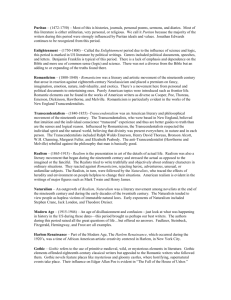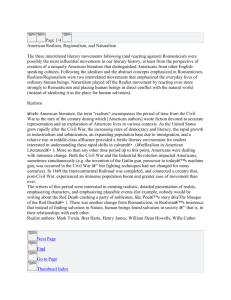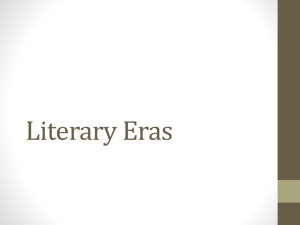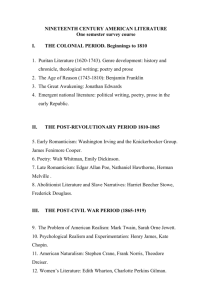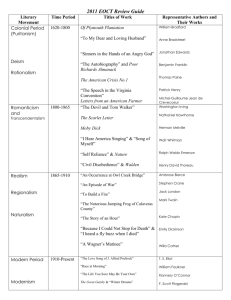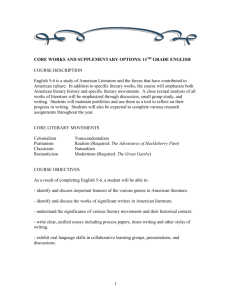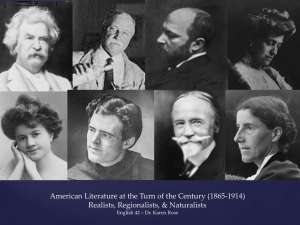Time Periods and Literary Movements
advertisement
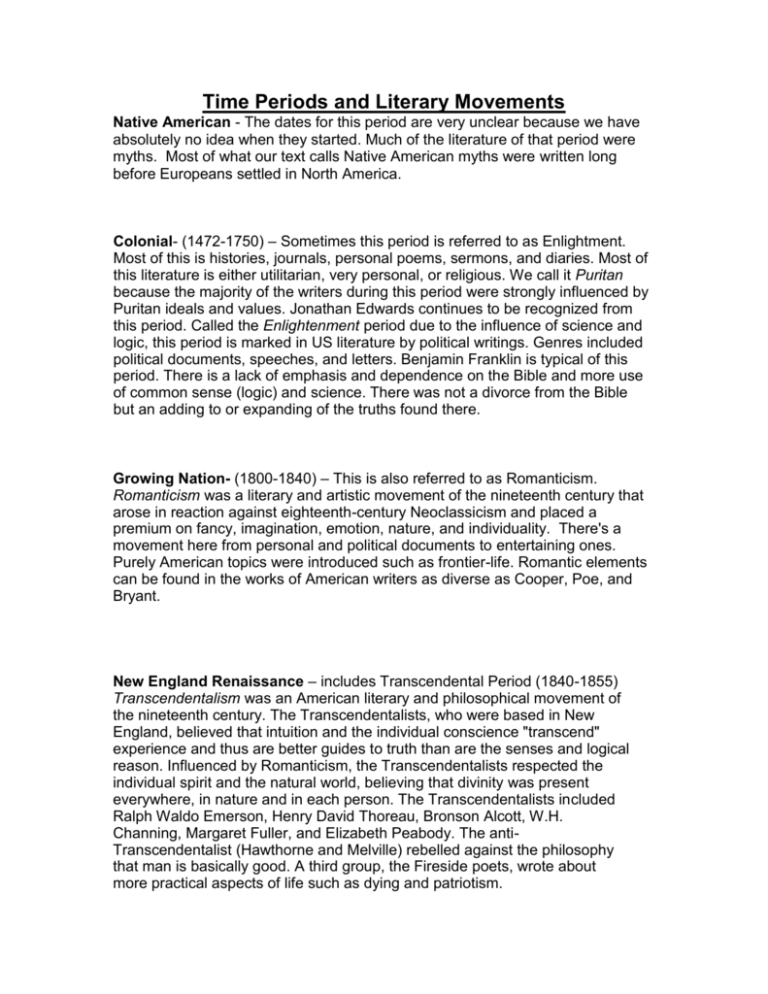
Time Periods and Literary Movements Native American - The dates for this period are very unclear because we have absolutely no idea when they started. Much of the literature of that period were myths. Most of what our text calls Native American myths were written long before Europeans settled in North America. Colonial- (1472-1750) – Sometimes this period is referred to as Enlightment. Most of this is histories, journals, personal poems, sermons, and diaries. Most of this literature is either utilitarian, very personal, or religious. We call it Puritan because the majority of the writers during this period were strongly influenced by Puritan ideals and values. Jonathan Edwards continues to be recognized from this period. Called the Enlightenment period due to the influence of science and logic, this period is marked in US literature by political writings. Genres included political documents, speeches, and letters. Benjamin Franklin is typical of this period. There is a lack of emphasis and dependence on the Bible and more use of common sense (logic) and science. There was not a divorce from the Bible but an adding to or expanding of the truths found there. Growing Nation- (1800-1840) – This is also referred to as Romanticism. Romanticism was a literary and artistic movement of the nineteenth century that arose in reaction against eighteenth-century Neoclassicism and placed a premium on fancy, imagination, emotion, nature, and individuality. There's a movement here from personal and political documents to entertaining ones. Purely American topics were introduced such as frontier-life. Romantic elements can be found in the works of American writers as diverse as Cooper, Poe, and Bryant. New England Renaissance – includes Transcendental Period (1840-1855) Transcendentalism was an American literary and philosophical movement of the nineteenth century. The Transcendentalists, who were based in New England, believed that intuition and the individual conscience "transcend" experience and thus are better guides to truth than are the senses and logical reason. Influenced by Romanticism, the Transcendentalists respected the individual spirit and the natural world, believing that divinity was present everywhere, in nature and in each person. The Transcendentalists included Ralph Waldo Emerson, Henry David Thoreau, Bronson Alcott, W.H. Channing, Margaret Fuller, and Elizabeth Peabody. The antiTranscendentalist (Hawthorne and Melville) rebelled against the philosophy that man is basically good. A third group, the Fireside poets, wrote about more practical aspects of life such as dying and patriotism. Division, War, and Reconciliation (1856 – 1865) Nearly all of the literary activity that occurred during the years during this period was in some way related to the Civil War. The War Between the States absorbed the creative energies of the nation. Notable speeches, songs, spirituals, letters, poems, and journals appeared. Many writers became involved in the war, and some of the most important war time literature was produced by the leaders from both sides. One towering literary figure emerged during the war time era – the poet Walt Whitman. Whit was also know as the Good Gray PoetRealism – also includes Naturalism (1865-1915) - Realism is the presentation in art of the details of actual life. Realism was also a literary movement that began during the nineteenth century and stressed the actual as opposed to the imagined or the fanciful. The Realists tried to write truthfully and objectively about ordinary characters in ordinary situations. They reacted against Romanticism, rejecting heroic, adventurous, unusual, or unfamiliar subjects. The Realists, in turn, were followed by the Naturalists, who traced the effects of heredity and environment on people helpless to change their situations. American realism grew from the work of local-color writers such as Bret Harte and Sarah Orne Jewett and is evident in the writings of major figures such as Mark Twain and Henry James. An outgrowth of Realism, Naturalism was a literary movement among novelists at the end of the nineteenth century and during the early decades of the twentieth century. The Naturalists tended to view people as hapless victims of immutable natural laws. Early exponents of Naturalism included Stephen Crane, Jack London, and Theodore Dreiser. Modern Age – also includes The Harlem Renaissance (1915-1946) - An age of disillusionment and confusion-just look at what was happening in history in the US during these dates-this period brought us perhaps our best writers. The authors during this period raised all the great questions of life … but offered no answers. Faulkner, Steinbeck, Fitzgerald, Hemingway, and Frost are all examples. Contemporary - (1946-present) - great stuff, but not a clear philosophy, and we will cover very little of this. Other terms to know: Classicism - Classicism is an approach to literature and the other arts that stresses reason, balance, clarity, ideal beauty, and orderly form in imitation of the arts of ancient Greece and Rome. Classicism is often contrasted with Romanticism, which stresses imagination, emotion, and individualism. Classicism also differs from Realism, which stresses the actual rather than the ideal. Local Color - Local Color is the use in a literary work of characters and details unique to a particular geographic area. Local color can be created by the use of dialect and by descriptions of customs, clothing, manners, attitudes, scenery, and landscape. Local-color stories were especially popular after the Civil War, bringing readers the West of Bret Harte, the Mississippi River of Mark Twain, and the New England of Sarah Orne Jewett. Gothic - Gothic refers to the use of primitive medieval, wild, or mysterious elements in literature. Gothic elements offended eighteenth-century classical writers but appealed to the Romantic writers who followed them. Gothic novels feature places like mysterious and gloomy castles, where horrifying, supernatural events take place. Their influence on Edgar Allan Poe is evident in "The Fall of the House of Usher."
